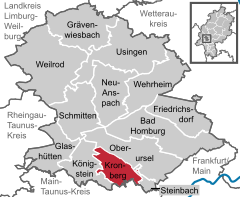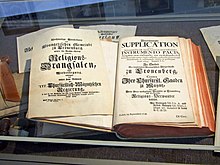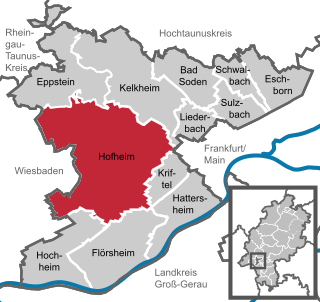
Hofheim is the administrative centre of Main-Taunus-Kreis district, in the south of the German state of Hesse. Its population in September 2020 was 39,946.
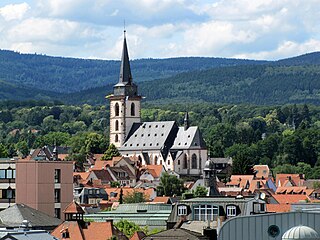
Oberursel (Taunus) (German:[oː.bɐ.ˈʊʁ.zl̩] ) is a town in Germany and part of the Frankfurt Rhein-Main urban area. It is located to the north west of Frankfurt, in the Hochtaunuskreis county. It is the 13th largest town in Hesse. In 2011, the town hosted the 51st Hessentag state festival.
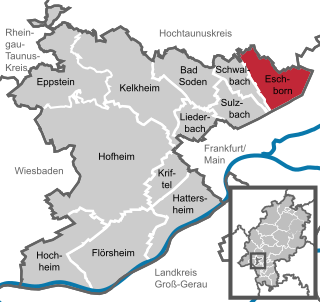
Eschborn is a town in the Main-Taunus district, Hesse, Germany. It is part of the Frankfurt Rhein-Main urban area and has a population of 21,488 (2018). Eschborn is home to numerous corporations due to its proximity to Frankfurt and relatively low business tax rate.

Michelstadt in the Odenwald is a town in the Odenwaldkreis (district) in southern Hesse, Germany between Darmstadt and Heidelberg. It has a population of 28,629 people.

Eppstein is a town in the Main-Taunus-Kreis, in Hesse, Germany. Eppstein lies west of Frankfurt am Main, around 12 km north east of the state capital Wiesbaden, and is at the edge of the Taunus mountains. The ruins of the Eppstein castle is a prominent landmark, and houses a museum.
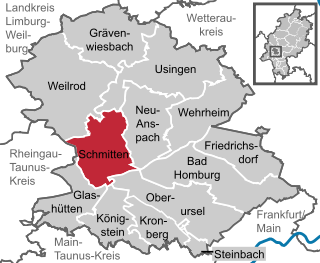
Schmitten im Taunus is a municipality in the Hochtaunuskreis in Hessen, Germany.

Königstein im Taunus is a health spa and lies on the thickly wooded slopes of the Taunus in Hesse, Germany. The town is part of the Frankfurt Rhein-Main urban area. Owing to its advantageous location for both scenery and transport on the edge of the Frankfurt Rhine Main Region, Königstein is a favourite residential town. Neighbouring places are Kronberg im Taunus, Glashütten, Schwalbach am Taunus, Bad Soden am Taunus and Kelkheim.

Schwalbach am Taunus, a town in the Main-Taunus-Kreis district, in Hesse, Germany, population about 14,000, is a dormitory town to Frankfurt, situated some 11 km east of Schwalbach. There is evidence of human habitation dating back to Neolithic times, and recorded history going back to 781 AD. Until the end of the Second World War, it was a farming village, but in the post-war era it expanded rapidly and became economically linked to Frankfurt. Schwalbach was granted Gemeinde (municipal) status in 1970.
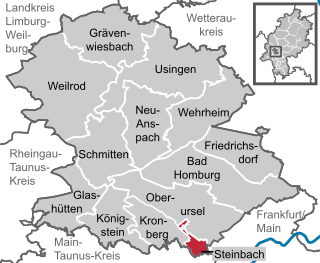
Steinbach is a town in the Hochtaunuskreis that borders Frankfurt am Main to the east. Other neighbouring towns are Oberursel, Kronberg im Taunus and Eschborn. It is in the German state of Hesse.
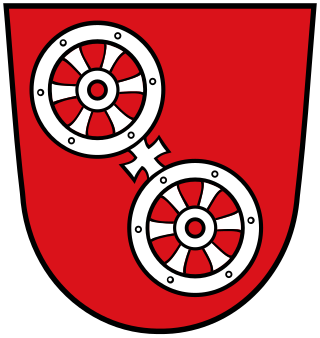
The Wheel of Mainz or Mainzer Rad, in German, was the coat of arms of the Archbishopric of Mainz and thus also of the Electorate of Mainz (Kurmainz), in Rhineland-Palatinate, Germany. It consists of a silver wheel with six spokes on a red background. The wheel can also be found in stonemasons' carvings and similar objects. Currently, the City of Mainz uses a double wheel connected by a silver cross.

Fürfeld is an Ortsgemeinde – a municipality belonging to a Verbandsgemeinde, a kind of collective municipality – in the Bad Kreuznach district in Rhineland-Palatinate, Germany. It belongs to the Verbandsgemeinde of Bad Kreuznach, whose seat is in the like-named town, although this lies outside the Verbandsgemeinde.

Julius Gustav Neubronner was a German apothecary, inventor, company founder, and a pioneer of amateur photography and film. He was part of a dynasty of apothecaries in Kronberg im Taunus. Neubronner was court apothecary to Kaiserin Friedrich, invented the pigeon photographer method for aerial photography, was one of the first film amateurs in Germany, and founded a factory for adhesive tapes. After his death, the company was directed for 70 years by his son Carl Neubronner.

The Homburg Railway is an 18 km line from Frankfurt am Main to Bad Homburg in the German state of Hesse. It was opened in 1860 as one of the first railway lines in Germany. It is now part of the Rhine-Main S-Bahn line S5 to Friedrichsdorf.
The Kronberg Railway is now the northern part of Frankfurt S-Bahn line S4, which connects Langen, Frankfurt am Main and Kronberg im Taunusin Hesse, Germany. The route branches off the Homburg line in Rödelheim and continues via Eschborn Süd, Eschborn and Niederhöchstadt to Kronberg.
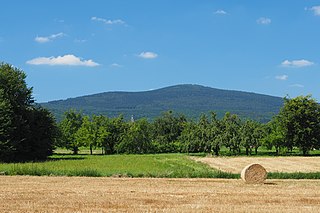
The Altkönig is the third highest mountain of the Taunus range in Hesse, Germany, reaching a height of 798.2 m above sea level (NHN).

Falkenstein Castle, also called New Falkenstein (Neu-Falkenstein), is a ruined hill castle at 450 m above sea level (NHN) in the eponymous climatic spa of Falkenstein, a quarter of Königstein im Taunus in the county of Hochtaunuskreis in the German state of Hesse.
Kronberg im Taunus is a town in the Hochtaunuskreis district, Hesse, Germany.
The 2021 Eschborn–Frankfurt was a road cycling one-day race that took place on 19 September 2021 in the Frankfurt Rhein-Main metro area in southwest Germany. It was the 60th edition of Eschborn–Frankfurt, but only the 58th to be held, and the 27th event of the 2021 UCI World Tour. The race returned to the UCI World Tour calendar after the 2020 edition was cancelled due to the COVID-19 pandemic. Traditionally, the race takes place on 1 May, the Labour Day holiday in Germany, but it was postponed due to COVID-19 precautions.

Rettershof is a crown domain northeast of Fischbach, a district of Kelkheim in the Vordertaunus. It goes back to a former Premonstratensian monastery. From the 12th century until 1559, nuns were resident at Retters, and later various owners used the estate and its lands as a farmstead. Today, in addition to its continued agricultural use, Rettershof is a popular regional excursion destination.

